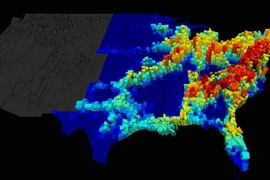However, a new MIT study comparing contagion rates in two scenarios — with and without travel restrictions — shows that even moderate measures of mobility restriction would be effective in controlling contagion in densely populated areas with highly interconnected road and transit networks. The researchers called the difference between infection rates in the two scenarios the “price of anarchy,” a concept from game theory that’s frequently used as a metric in studies of the controlled use of transportation networks.
The study, published online July 31 in the Journal of the Royal Society Interface, is the first to link the concept of price of anarchy to the spread of contagion. It assumes that transmission of the news of the epidemic (which influences how people select travel routes) and the epidemic itself follow the same mobility network, and uses standard epidemiological models to simulate the flow of contagion.
The researchers — Ruben Juanes, the ARCO Associate Professor in Energy Studies in MIT’s Department of Civil and Environmental Engineering, graduate student Christos Nicolaides and research associate Luis Cueto-Felgueroso — used data from the 2000 U.S. census to establish the aggregate daily flux of people commuting between counties.
Previous research had shown that when individuals become aware of an epidemic, they travel not by taking the shortest route, but by taking the shortest route that avoids infected areas — even if they’re already infected — a strategy that exposes people in uninfected areas to disease. Such “selfish behavior,” as it’s called in game theory, is in direct opposition to the strategy of policymakers, who presumably would act in the benefit of the greater social good by routing infected individuals through areas where infection rates were already high.
The MIT study shows that the price of anarchy in some regions of the United States, such as along Interstate 95 in the Northeast, would be considerable. For a moderately contagious disease — one in which every infected person infects, on average, two others — restricting individuals to specific travel routes would decrease infection rates by as much as 50 percent.
“In an area with high connectivity, the outcome of action coordinated by officials is going to be better than selfish action, but the economic and social costs of disruption could sometimes be too high,” Juanes says. “In other cases, there would be an enormous benefit to having authorities impose travel restrictions. The price of anarchy is a quantitative measure that identifies areas where intervention might pay off.”
“Although the study is an idealized scenario, it does give insight to authorities about when and where it would be important to impose route restrictions on human mobility in the case of an emergent outbreak or in the extreme case of bioterrorism,” says Nicolaides, the paper’s first author, who was funded by a Vergottis Fellowship from the MIT School of Engineering. “But you have to take into account the structure of the underlying mobility network and its traffic properties. Imposing policy-initiated action in areas with low traffic would not render substantial benefits for the containment of an epidemic.”
In their models, the researchers tracked an infectious disease as it spread via commuting networks in the contiguous United States, and found that the price of anarchy for contagion varies depending on the proximity of a network to major commuting corridors.
“A commuting network may be very local, but some contagion is related to more distant travel networks,” Cueto-Felgueroso says. “That’s why we see a higher price of anarchy near major arteries, like Interstate 95 in the northeastern United States.”
The researchers had previously studied the spread of disease through the air transportation network and found that the interconnectivity and location of an airport in the network, not just the number of travelers moving through it, were key to its ability to spread disease.
Juanes says the next step in this work is to measure the price of anarchy for contagion in the world’s 7,000 airports.
“In my view the MIT paper could be a game-changer in the field of epidemic modeling,” says Dirk Brockmann, an associate professor of engineering sciences and applied mathematics at Northwestern University who was not involved in the research. “Including decision-making and game-theoretic components into models of disease dynamics is massively overdue and essential, as even the most sophisticated models do not account for this type of feedback. Since mobility is such a sensitive component in terms of shaping disease dynamics, the approach the researchers take is very plausible, and it identifies clearly the intriguing interplay of selfish action versus policy action in the context of epidemiology. This is going to be very important in the future.”







